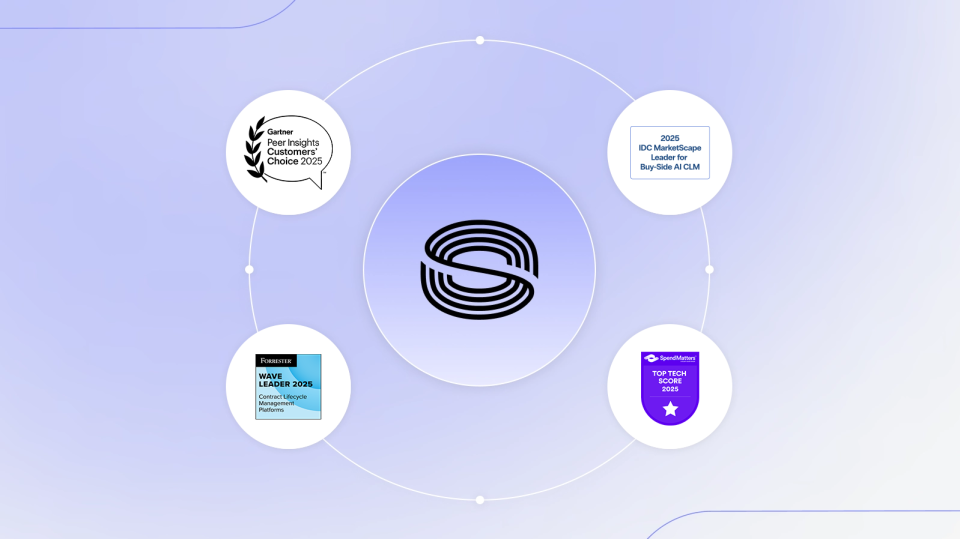Contract Migration: From Messy Folders to Smart Data

- Last Updated: Aug 26, 2025
- 15 min read
- Arpita Chakravorty
Imagine this: your finance team needs to verify the auto-renewal date on a critical supplier agreement. The hunt begins. Is it in the “ContractsFinal” folder on the shared drive? Or maybe “FinalContracts_V2”? Perhaps it’s in a filing cabinet down the hall, or worse, sitting on the desktop of an employee who left the company six months ago. By the time you find it—if you find it—the renewal window has passed, locking you into another year of unfavorable terms.
What begins as a simple search for a date can snowball into missed obligations, lost revenue, and strained supplier relationships.
This chaotic scramble is an everyday reality for countless businesses. Your contracts, which are supposed to be your company’s most valuable assets, are often scattered, forgotten, and unmanaged. This is where contract migration comes in, transforming a disorganized liability into a strategic advantage.
What Is Contract Migration?
At its core, contract migration is the process of moving contracts from their current locations—like shared drives, old systems, or physical cabinets—into a single, centralized digital repository, typically a Contract Lifecycle Management (CLM) platform.
But hold on, it’s not just a simple copy-and-paste job. A common misconception is that migration just means moving digital files from one folder to another. True, intelligent migration goes much deeper. It involves not only transferring the document itself but also using technology like AI to read, understand, and extract the vital information trapped inside. This is the difference between having a digital filing cabinet and having a smart, searchable contract database that works for you. Gaining this level of control is a core part of modern contract lifecycle management.

This visual clarifies the fundamental difference between simple contract data transfer and intelligent contract migration that extracts vital contract information, helping readers grasp the core concept.
Intelligent migration turns the static text of your contracts into active, usable data. Think about instantly knowing:
- Which contracts are expiring in the next 90 days?
- What are our total payment obligations for the next quarter?
- Which agreements contain a non-standard liability clause?
Answering these questions becomes a simple query, not a frantic, week-long manual review.
Find out in the blog AI Contract Review why modern businesses rely on AI to review contracts faster, smarter, and at scale.
Simple Migration vs. Intelligent Contract Migration
A digital filing cabinet may sound convenient, but it doesn’t solve the underlying problem. Here’s how simple migration compares to true intelligent migration:
Aspect | Simple Migration | Intelligent Migration |
Process | File transfer only | File + metadata extraction |
Searchability | Limited to filenames | Full-text + semantic search |
Risk Management | Minimal | Visibility into obligations, clauses, renewals |
Business Value | Digital archive | Actionable, data-rich repository |
This shift—from storage to intelligence—is where organizations unlock the real ROI of contract migration.
Why You Can’t Afford to Ignore Your Contracts Anymore
Leaving your contracts scattered and unmanaged isn’t just inefficient; it’s a significant business risk. A 2021 World Commerce & Contracting report found that poor contract management can cost companies an average of 9% of their annual revenue. That value leakage comes from missed deadlines, accidental renewals, and a failure to enforce negotiated terms.
Successful contract migration is a cornerstone of digital transformation in contract management. It’s about more than just getting organized. It’s about:
- Minimizing Risk: Gaining a clear view of all your obligations, renewal dates, and compliance requirements allows you to proactively manage risk instead of reacting to crises.
- Unlocking Value: When you can easily analyze your contracts, you can identify opportunities for cost savings, renegotiate better terms, and ensure you’re getting the full value you negotiated.
- Boosting Efficiency: Your legal, procurement, and finance teams can stop wasting time hunting for documents and focus on strategic work that drives the business forward.
- Enabling Business Intelligence: A centralized, data-rich contract repository allows you to spot trends, benchmark performance, and make smarter, data-driven decisions.
Why Contract Migration Matters Across Industries
Contracts don’t live in a vacuum. The impact of migration looks different depending on the industry you operate in:
- Healthcare – Ensure compliance with HIPAA and HITECH by consolidating patient data agreements, BAAs, and supplier contracts into one auditable system.
- Financial Services – Maintain audit readiness and regulatory compliance with structured, transparent records of loan, investment, and vendor agreements.
- Manufacturing & Procurement – Gain full visibility into supplier performance, payment obligations, and renewal timelines across global supply chains.
- Technology & SaaS – Centralize subscription renewals, MSAs, and vendor agreements to reduce churn and maintain tighter control over recurring revenue.
No matter the sector, contract migration delivers the same core outcome: clarity and control that scale with your business.
Your Roadmap: A Step-by-Step Contract Migration Playbook
Embarking on a contract migration project can feel like a monumental task, but it doesn’t have to be overwhelming. By breaking the journey down into logical phases, you can create a clear and manageable plan. A solid contract management strategy is your best first step to ensuring the project aligns with your broader business goals..
Here’s a look at the key phases involved:
Phase 1: Plan & Scope
Before you move a single file, you need a plan. Ask the big questions: Which contracts are we migrating first? What are our goals for this project? Who needs to be involved from legal, IT, finance, and procurement? Defining your scope and success metrics upfront is critical.
Phase 2: Locate & Consolidate
This is the treasure hunt phase. You need to find every contract, whether it’s on a laptop, in a shared folder, an email inbox, or a physical cabinet. The goal is to gather everything into a single staging area before you begin sorting.
Phase 3: Cleanse & Organize
Now the real work begins. This phase involves removing duplicate documents, identifying which version is the true “master” agreement, and grouping related documents (like amendments and SOWs) with their parent contracts. A clean dataset is the foundation of a successful migration.
Phase 4: Extract & Enrich
This is where AI-powered technology shines. Instead of manually reading hundreds or thousands of contracts, an AI-native CLM platform can automatically extract key metadata—like parties, dates, values, and obligations—and even complex clauses related to liability, termination, and governance. This transforms your flat documents into rich, structured data.
Key Metadata to Extract During Contract Migration
Not all data points are equally valuable. Intelligent migration ensures you capture the information that drives business decisions and compliance outcomes. Critical metadata typically includes:
- Parties & Contacts – Who signed and who is responsible for obligations.
- Key Dates – Effective dates, renewal windows, termination deadlines.
- Financials – Payment terms, contract value, penalties, and discounts.
- Jurisdiction & Governing Law – Critical for risk management and dispute resolution.
- Clauses & Obligations – From liability and indemnity to SLAs, NDAs, and termination rights.
With this metadata extracted, contracts stop being static PDFs and become rich data sources that power proactive decision-making.
Explore the blog Contract Data Extraction to see how AI transforms static agreements into structured, searchable intelligence.
Phase 5: Validate & Go-Live
The final step is to ensure the accuracy of the extracted data. This often involves a mix of automated checks and human spot-checks to validate critical information. Once you’re confident in the data’s integrity, you can “go live” and move the enriched contracts into your new CLM system.
Dodging the Potholes: Common Migration Challenges
While the benefits are clear, the path to successful contract migration has its share of potential pitfalls. Being aware of these challenges ahead of time is the best way to avoid them. A good starting point is to familiarize yourself with general contract management best practices, as they provide a solid foundation for any contract-related project.

This visual mnemonic helps readers remember and anticipate the key challenges faced during contract migration, reinforcing their preparedness and strategic planning.
Here are the five big hurdles to watch out for:
- Poor Data Quality – The “garbage in, garbage out” principle absolutely applies here. If you’re starting with messy, incomplete, or inconsistent contract data (like missing signatures or conflicting versions), your final repository will be just as unreliable. A thorough cleansing phase is non-negotiable.
- Outdated Legacy Systems – Pulling data from old, unsupported systems can be technically complex. You may encounter incompatible file formats or struggle to export the information you need, requiring specialized IT support.
- Lack of User Adoption – The most technologically advanced system is useless if no one uses it. If you don’t involve end-users early, provide proper training, and clearly communicate the benefits of the new system, your team may revert to their old, comfortable (and chaotic) ways of working.
- Stakeholder Misalignment – Migration touches Legal, Procurement, Finance, and IT. Without clear ownership and shared goals, teams may prioritize conflicting outcomes—leading to delays, duplicated efforts, or missed requirements. Early alignment and defined responsibilities are critical.
- Compliance Risks – Contracts often carry sensitive obligations tied to regulations like GDPR, HIPAA, or SOX. If compliance-related metadata is overlooked or misclassified during migration, the organization may face exposure in audits or disputes. A compliance-first mindset during extraction and validation is essential.
Best Practices for Successful Contract Migration
Challenges are unavoidable, but proven practices can minimize risk and accelerate results. To maximize impact:
- Start with a Pilot Migration – Test your process on a smaller subset of contracts before scaling.
- Standardize Templates – Use consistent structures so AI extraction delivers cleaner results.
- Leverage AI-Powered CLM – Automate metadata extraction and reduce manual effort.
- Involve Stakeholders Early – Get Legal, Procurement, and Finance aligned before go-live.
- Close the Feedback Loop – Monitor accuracy, gather feedback, and refine processes iteratively.
When these best practices are built into your migration roadmap, the process shifts from a one-off project to a repeatable discipline that scales.
Thinking About a New System? What to Look For
If you’re undertaking a migration, you’re likely moving your contracts to a new, better system. Selecting the right platform is just as important as the migration process itself. When evaluating solutions, consider looking for a system that excels at contract automation to ensure you get the most out of your newly organized data.
As you build your business case for enterprise-wide CLM software, focus on platforms that offer:
- Powerful AI Extraction: How accurate and comprehensive is the platform’s ability to pull data from your legacy contracts? Can it handle complex, non-standard language?
- Ease of Use: Is the interface intuitive? A system that is easy for your team to learn and use will see much higher adoption rates.
- Seamless Integration: Can the platform connect with your other essential business systems, like ERP and CRM, to create a single source of truth for commercial data?
- Proven Success: Does the vendor have a track record of successful migrations for companies of your size and in your industry? Look for real-world contract management case studies that demonstrate their expertise. For a broader market view, understanding how to use industry analyses like Gartner’s Magic Quadrant for solution selection can also be incredibly helpful.
Explore the blog Gartner CLM Magic Quadrant to see how leading CLM solutions stack up in vision and execution.
The First Step to a Smarter Future
Contract migration is more than an IT project; it’s a fundamental business transformation. It’s the critical first step in moving your contracts from dusty, forgotten files to dynamic, intelligent assets that protect your business and drive growth. By taking a planned, phased approach and choosing the right technology partner, you can turn contractual chaos into a powerful source of clarity and control.
For organizations serious about digital transformation, contract migration is not optional—it’s the foundation. Done right, it doesn’t just tidy your documents; it unlocks intelligence that drives growth, compliance, and resilience.
Frequently Asked Questions (FAQs)
How long does a typical contract migration project take?
The timeline can vary significantly based on the volume and complexity of your contracts, as well as the quality of your existing data. A small project with a few hundred well-organized contracts might take a few weeks, while a large enterprise with tens of thousands of contracts scattered across multiple systems could take six months or more. The planning and data cleansing phases often take the most time.
What kind of team do I need to assemble for a contract migration?
A successful contract migration requires a cross-functional team. You'll typically need a project lead, along with representatives from Legal (to interpret contract language), IT (to handle technical extraction and integration), Procurement and Sales (as the primary contract owners), and Finance (to validate financial data).
Can I migrate contracts that are not in English?
Yes, advanced AI-powered CLM platforms can handle contracts in multiple languages. When selecting a solution, be sure to verify its multilingual capabilities and the accuracy of its data extraction for the specific languages in your portfolio.
What happens to paper contracts during migration?
Paper contracts need to be digitized before they can be migrated. This involves a process of scanning the documents and converting them into text-searchable digital files using Optical Character Recognition (OCR) technology. This is a critical step for creating a truly comprehensive digital repository.
Is it better to migrate all contracts at once or in phases?
For most organizations, a phased approach is recommended. You might start with a specific contract type (e.g., all master services agreements) or contracts from a single department. This allows you to refine your process, learn valuable lessons on a smaller scale, and demonstrate early wins before tackling the entire portfolio.
How does contract migration improve compliance audits?
By consolidating agreements into a centralized, structured repository, audits move from manual, weeks-long exercises to quick, data-driven checks. Key terms, obligations, and dates are instantly retrievable.
What role does AI play in accelerating contract migration timelines?
AI automates the extraction of metadata and clauses, reducing months of manual review to days. It also improves accuracy by standardizing how data is captured and classified.
Can contract migration reduce costs for procurement teams?
Yes. By surfacing supplier terms, pricing commitments, and renewal windows, procurement teams can negotiate better deals, avoid overpayments, and prevent auto-renewals of unfavorable contracts.
What’s the difference between contract migration and contract digitization?
Digitization is the process of converting paper contracts into digital files. Migration goes further by enriching those files with metadata, obligations, and clauses—turning them into searchable, strategic assets.


